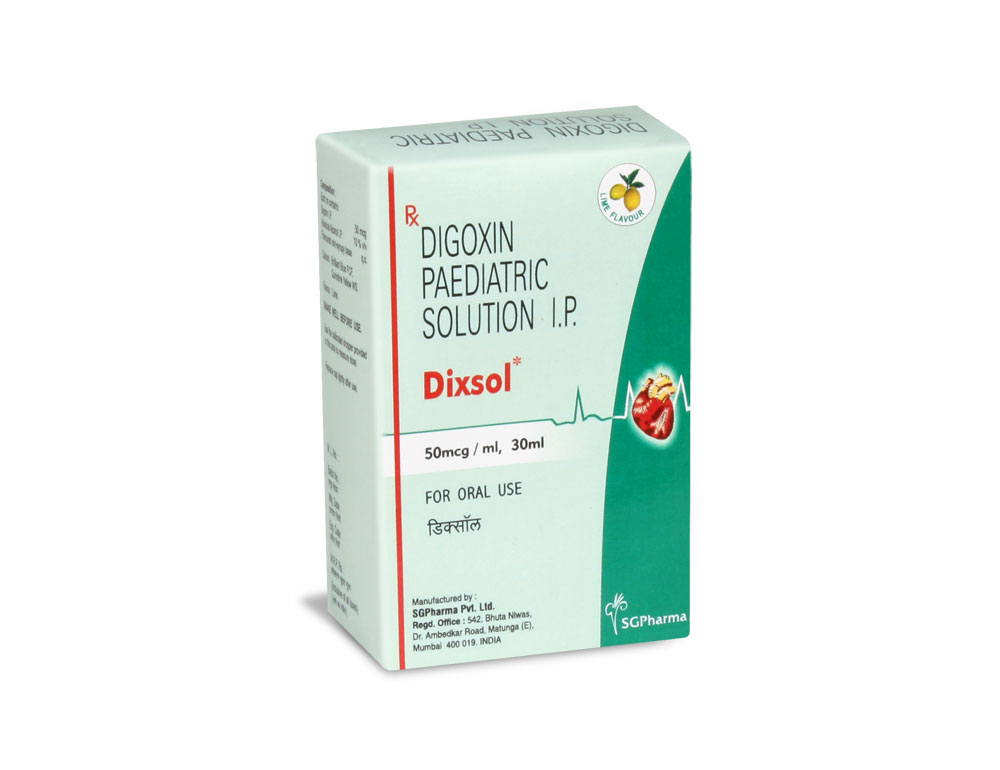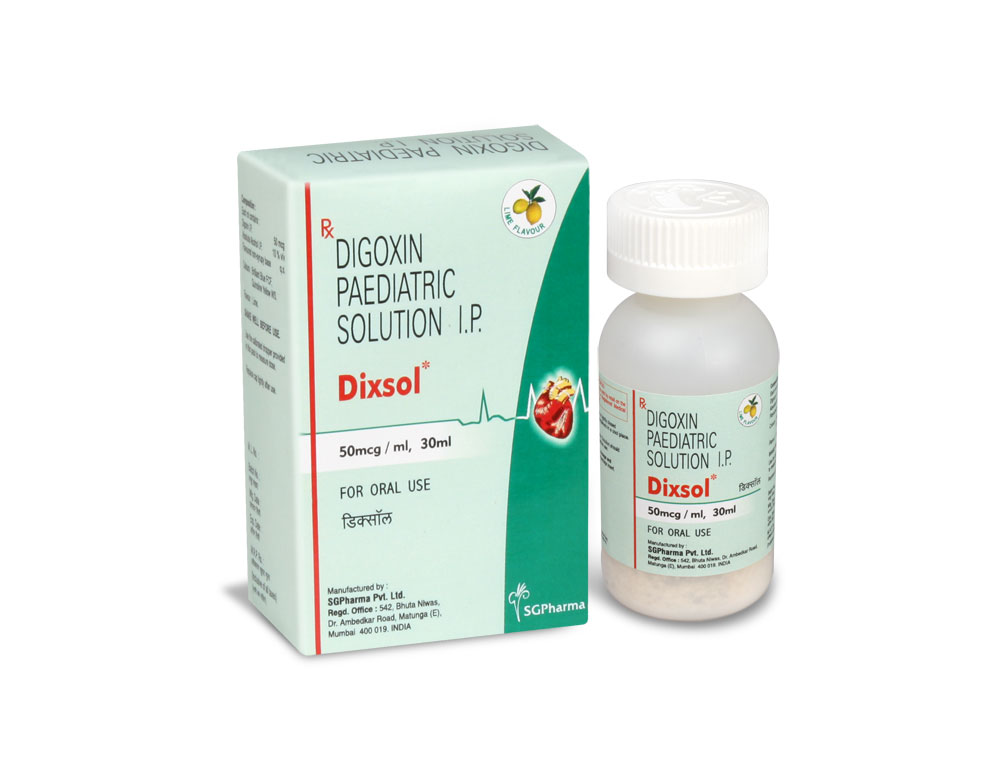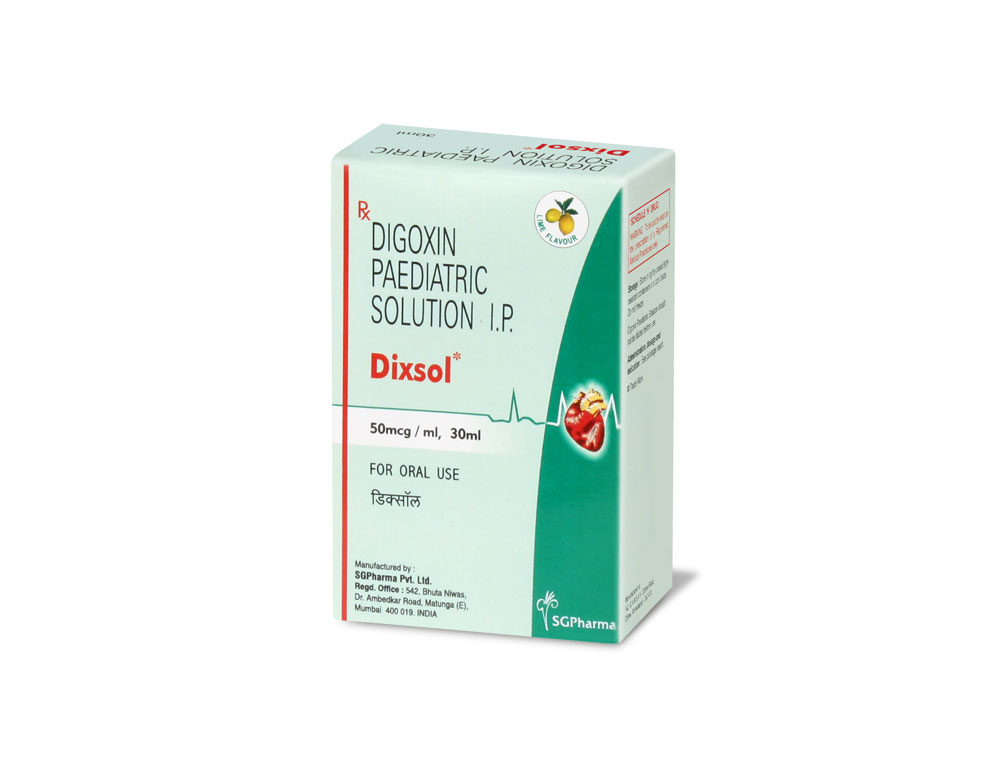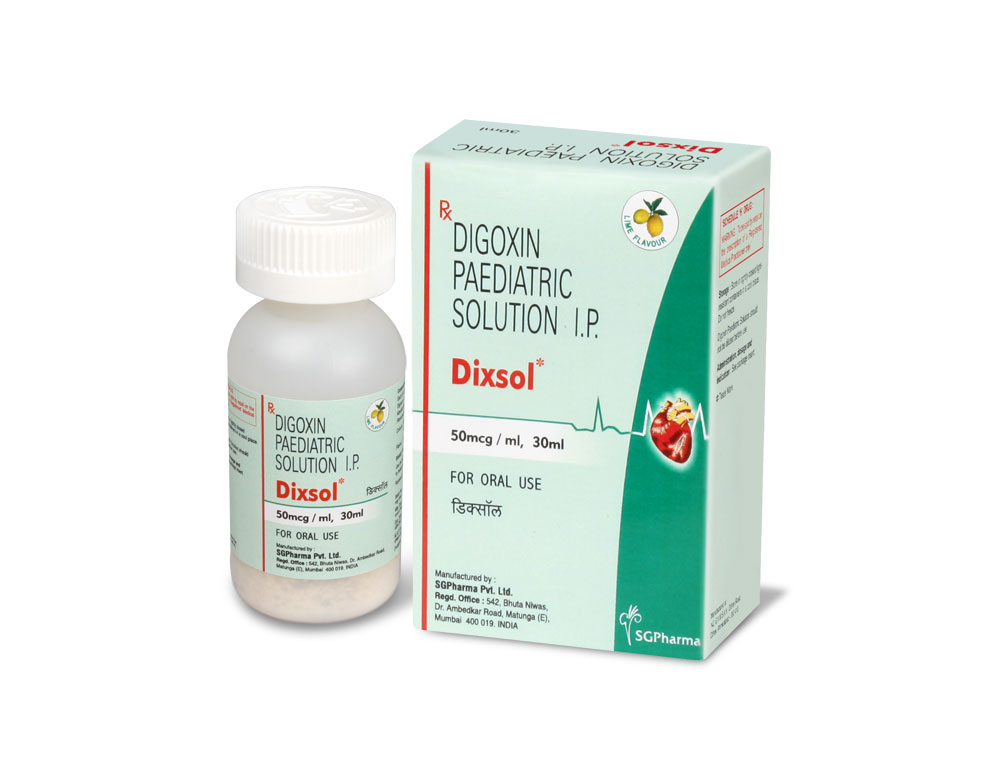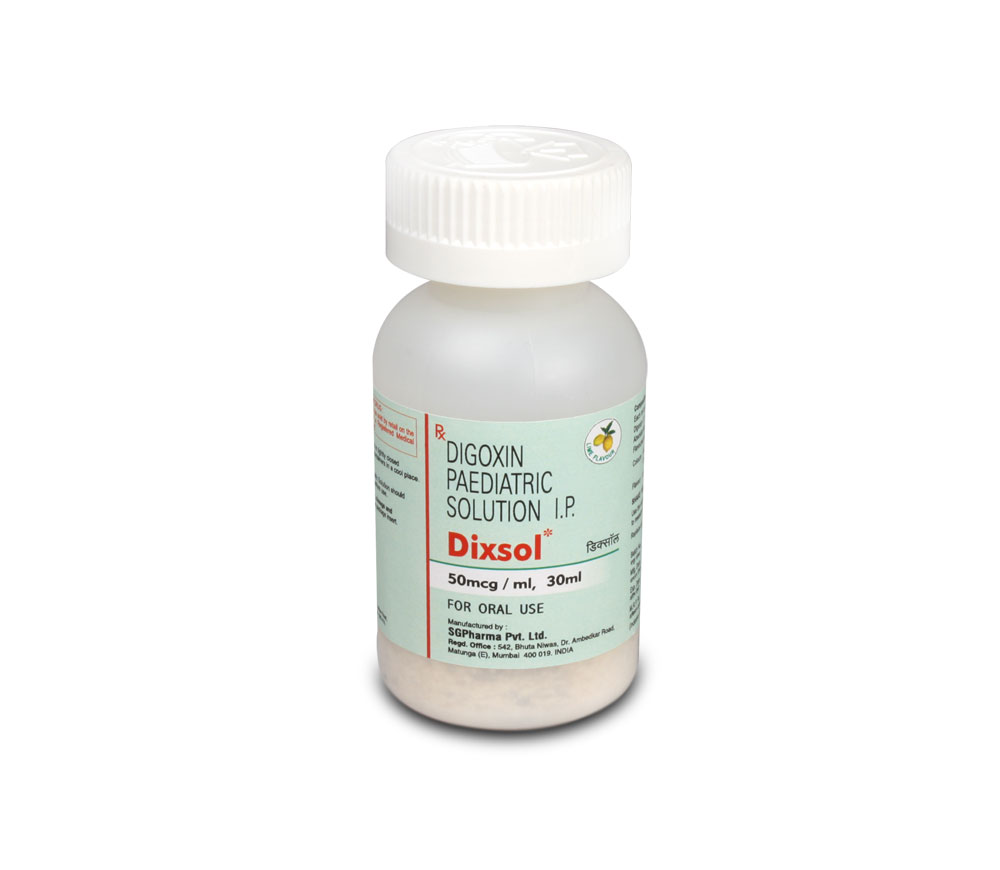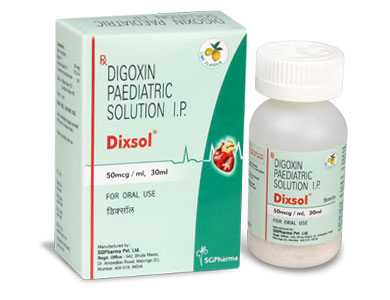
0.05 mg/ml, 30 ml/60 ml
For the use of a Registered Medical Practitioner or a Hospital or a Institution only.
DIXSOL (Digoxin) is a cardiotonic glycoside obtained from the leaves of Digitalis lanata Ehrhart (Scrophulariaceae). Chemically, Digoxin is 3b-[(O-2,6-dideoxy-b-D-ribo-hexopyranosyl-(1®4)-O-2,6-dideoxy-b-D-ribo-hexopyranosyl-(1128W1A4)-2,6-dideoxy-b-D ibohexopyranosyl) oxy]-12b,1428b-dihydroxy-5b-card-20(22)-enolide. The molecular formula is C41H64O14 and molecular weight is 780.95.
STRUCTURAL FORMULA :
Its structural formula is :
-Structure.jpg)
DIXSOL is a clear, yellow, lime flavoured solution.
COMPOSITION :
Each mL contains :
Digoxin I.P. 50 mcg
Absolute Alcohol I.P. 10% v/v
Flavoured non-syrupy base q.s.
Colours : Brilliant Blue FCF, Quinoline Yellow WS
Flavour : Lime
ACTIONS :
Digoxin increases contractility of the myocardium by direct activity. This effect is proportional to dose in the lower range and some effect is achieved with quite low dosing; it occurs even in normal myocardium although it is then entirely without physiological benefit. The primary action of digoxin is specifically to inhibit adenosine triphosphatase and thus sodium-potassium (Na+-K+) exchange activity, the altered ionic distribution across the membrane resulting in an augmented calcium ion influx and thus an increase in the availability of calcium at the time of excitation- contraction coupling. The potency of digoxin may therefore appear considerably enhanced when the extracellular potassium concentration is low, with hyperkalaemia having the opposite effect. Digoxin exerts the same fundamental effect of inhibition of the Na+-K+exchange mechanism on cells of the autonomic nervous system, stimulating them to exert indirect cardiac activity such as diminished impulse conduction rate through the atria and atrio-ventricular node (vagotonic) and senzitisation of the carotid sinus nerves (sympathomimetic). Indirect cardiac contractility changes also result from changes in venous compliance brought about by the altered autonomic activity and by direct venous stimulation. The interplay between direct and indirect activity governs the total circulatory response, which is not identical for all subjects. In the presence of certain supraventricular arrhythmias, the neurogenically mediated slowing of AV conduction is paramount. The degree of neurohormonal activation occurring in patients with heart failure is associated with clinical deterioration and an increased risk of death. Digoxin reduces activation of both the sympathetic nervous system and the (renin-angiotensin) system independently of its inotropic actions and may favourably influence survival. Whether this is achieved via direct sympathoinhibitory effects or by re-sensitizing baroreflex mechanisms remains unclear.
PHARMACOKINETICS :
Upon oral administration, digoxin is absorbed from the stomach and upper part of the small intestine. When digoxin is taken after meals the rate of absorption is slowed, but the total amount of digoxin absorbed is usually unchanged. When taken with meals high in fibre, however, the amount absorbed from an oral dose may be reduced. Using the oral route the onset of effect occurs in 0.5 to 2 hours and reaches its maximum at 2 to 6 hours. The bioavailability of orally administered digoxin is 75 % as paediatric elixir. The initial distribution of digoxin from the central to the peripheral compartment generally lasts from 6 to 8 hours. This is followed by a more gradual decline in serum digoxin concentration, which is dependent upon digoxin elimination from the body. The volume of distribution is large (Vdss = 510 litres in healthy volunteers), indicating digoxin to be extensively bound to body tissues. The highest digoxin concentrations are seen in the heart, liver and kidney, that in the heart averaging 30-fold that in the systemic circulation. Although the concentration in skeletal muscle is far lower, this store cannot be overlooked since skeletal muscle represents 40 % of total body weight. Of the small proportion of digoxin circulating in plasma, approximately 25 % is bound to protein. The major route of elimination is renal excretion of the unchanged medicine. Digoxin is a substrate for P-glycoprotein. As an efflux protein on the apical membrane of enterocytes, P-glycoprotein may limit the absorption of digoxin. P-glycoprotein in renal proximal tubules appears to be an important factor in the renal elimination of digoxin. Following intravenous administration to healthy volunteers, between 60 % and 75 % of a digoxin dose is recovered unchanged in the urine over a 6 day follow-up period. Total body clearance of digoxin has been shown to be directly related to renal function and percent daily loss is thus a function of creatinine clearance, which in turn may be estimated from a stable serum creatinine. The total and renal clearances of digoxin have been found to be 193 ± 25 mL/min and 152 ± 24 mL/min in a healthy control population.
In a small percentage of individuals, orally administered digoxin is converted to cardioinactive reduction products (Digoxin reduction products or DRPs) by colonic bacteria in the gastrointestinal tract. In these subjects over 40 % of the dose may be excreted as DRPs in the urine. Renal clearances of the two main metabolites, dihydrodigoxin and digoxygenin, have been found to be 79 ± 13 mL/min and 100 ± 26 mL/min respectively.
INDICATIONS :
DIXSOL is indicated in the management of chronic cardiac failure where the dominant problem is systolic dysfunction. Its therapeutic benefit is greatest in those patients with ventricular dilatation. DIXSOL is specifically indicated where cardiac failure is accompanied by atrial fibrillation. DIXSOL is indicated in the management of certain supraventricular arrhythmias, particularly chronic atrial flutter and fibrillation.
Administration :
DIXSOL should not be diluted before use.
Use calibrated dropper provided in this pack to measure dose.
Instructions for use of dropper :
1. Pull out the rubber teat slightly to facilitate administration.
2. Unscrew cap and insert the dropper assembly.
3. Replace cap tightly after use.
Dosage :
The dose of DIXSOL for each patient has to be tailored individually according to age, lean body weight and renal function. Suggested doses are intended only as an initial guide. DIXSOL Oral Solution, 50 mcg in 1mL, is supplied with a graduated pipette and this should be used for measurement of all doses.
Adults and children over 10 years :
Rapid Oral Loading :
750 to 1500 mcg (0.75 to 1.5 mg) as a single dose. Where there is less urgency, or greater risk of toxicity e.g. in the elderly, the oral loading dose should be given in divided doses 6 hours apart, with approximately half the total dose given as the first dose. Clinical response should be assessed before giving each additional dose. (See Warnings and Precautions)
Slow Oral Loading :
250 to 750 mcg (0.25 to 0.75 mg) should be given daily for 1 week followed by an appropriate maintenance dose. A clinical response should be seen within one week.
NOTE : The choice between slow and rapid oral loading depends on the clinical state of the patient and the urgency of the condition.
CONTRAINDICATIONS :
DIXSOL is contraindicated in intermittent complete heart block or second degree atrioventricular block, especially if there is a history of Strokes-Adams attacks. DIXSOL is contraindicated in arrhythmias caused by cardiac glycoside intoxication. DIXSOL is contraindicated in supraventricular arrhythmias associated with an accessory atrioventricular pathway, as in the Wolff-Parkinson- White syndrome, unless the electrophysiological characteristics of the accessory pathway and any possible deleterious effect of digoxin on these characteristics have been evaluated. If an accessory pathway is known or suspected to be present and there is no history of previous supraventricular arrhythmias, DIXSOL is similarly contraindicated. DIXSOL is contraindicated in ventricular tachycardia or ventricular fibrillation. DIXSOL is contraindicated in hypertrophic obstructive cardiomyopathy, unless there is concomitant atrial fibrillation and heart failure but even then caution should be exercised if DIXSOL is to be used. DIXSOL is contraindicated in patients known to be hypersensitive to digoxin or other digitalis glycosides.
Arrhythmias may be precipitated by digoxin toxicity, some of which can resemble arrhythmias for which the drug could be advised. For example, atrial tachycardia with varying atrioventricular block requires particular care as clinically the rhythm resembles atrial fibrillation.
In some cases of sinoatrial disorder (i.e. sick sinus syndrome) digoxin may cause or exacerbate sinus bradycardia or cause sinoatrial block. Determination of the serum digoxin concentration may be very helpful in making a decision to treat with further digoxin, but toxic doses of other glycosides may crossreact in the assay and wrongly suggest apparently satisfactory measurements. Observations during the temporary withholding of digoxin may be more appropriate. the preceding two weeks the recommendations for initial dosing of a patient should be reconsidered and a reduced dose is advised. The dosing recommendations should be reconsidered if patients are elderly or there are other reasons for the renal clearance of digoxin being reduced. A reduction in both initial and maintenance doses should be considered. Hypokalaemia sensitises the myocardium to the actions of cardiac glycosides. Hypoxia, hypomagnesaemia and marked hypercalcaemia increase myocardial sensitivity to cardiac glycosides.
Administering DIXSOL to a patient with thyroid disease requires care. Initial and maintenance doses of DIXSOL should be reduced when thyroid function is subnormal. In hyperthyroidism there is relative digoxin resistance and the dose may have to be increased. During the course of treatment of thyrotoxicosis, dosage should be reduced as the thyrotoxicosis comes under control. Patients with malabsorption syndrome or gastro-intestinal reconstruction may require larger doses of digoxin. The risk of provoking dangerous arrhythmias with direct current cardioversion is greatly increased in the presence of digitalis toxicity and is in proportion to the cardioversion energy used. For elective direct current cardioversion of a patient who is taking digoxin, the drug should be withheld for 24 hours before cardioversion is performed. In emergencies, such as cardiac arrest, when attempting cardioversion the lowest effective energy should be applied. Direct current cardioversion is inappropriate in the treatment of arrhythmias thought to be caused by cardiac glycosides. Many beneficial effects of digoxin on arrhythmias result from a degree of atrioventricular conduction blockade. However, when incomplete atrioventricular block already exists, the effects of a rapid progression in the block should be anticipated. In complete heart block the idioventricular escape rhythm may be suppressed.The administration of digoxin in the period immediately following myocardial infarction is not contra-indicated. However, the use of inotropic drugs in some patients in this setting may result in undesirable increases in myocardial oxygen demand and ischaemia, and some retrospective follow-up studies have suggested digoxin to be associated with an increased risk of death. However, the possibility of arrhythmias arising in patients who may be hypokalaemic after myocardial infarction and are likely to be cardiologicially unstable must be borne in mind. The limitations imposed thereafter on direct current cardioversion must also be remembered.
Pregnancy : Pregnancy Category C.
Teratogenic Effects :
Pregnancy Category C. Animal reproduction studies have not been conducted with digoxin. It is also not known whether digoxin can cause foetal harm when administered to a pregnant woman or can affect reproduction capacity. Digoxin should be given to a pregnant woman only if clearly needed.
Nursing mothers :
Studies have shown that digoxin concentrations in the mother’s serum and milk are similar. However, the estimated exposure of a nursing infant to digoxin via breast feeding will be far below the usual infant maintenance dose. Therefore, this amount should have no pharmacologic effect upon the infant. Nevertheless, caution should be exercised when digoxin is administered to a nursing woman.
Paediatric Use :
Newborn infants display considerable variability in their tolerance to digoxin. Premature and immature infants are particularly sensitive to the effects of digoxin, and the dosage of the drug must not only be reduced but must be individualised according to their degree of maturity. Digitalis glycosides can cause poisoning in children due to accidental ingestion.
Geriatric Use :
The majority of clinical experience gained with digoxin has been in the elderly population. This experience has not identified differences in response or adverse effects between the elderly and younger patients. However, this drug is known to be substantially excreted by the kidney, and the risk of toxic reactions to this drug may be greater in patients with impaired renal function. Because elderly patients are more likely to have decreased renal function, care should be taken in dose selection, which should be based on renal function, and it may be useful to monitor renal function.
OVERDOSAGE :
Nausea, vomiting and anorexia may be among the earliest symptoms of digoxin overdosage; diarrhoea and abdominal pain may also occur. Certain neurological effects are also common symptoms of digoxin overdosage and include headache, facial pain, fatigue, weakness, dizziness, drowsiness, disorientation, mental confusion, bad dreams and more rarely delirium, acute psychoses and hallucinations. Convulsions have also been reported. Hyperkalaemia occurs in acute overdosage. Frequent etopic heart beats indicate poisoning of the myocardium and atricular or ventricular arrhythmias and defects of conduction may be early indications of overdosage.
Administration of Potassium :
Massive Digitalis Overdosage :
Manifestations of life-threatening toxicity include ventricular tachycardia or ventricular fibrillation, or progressive bradyarrhythmias, or heart block. The administration of more than 10 mg of digoxin in a previously healthy adult or more than 4 mg in a previously healthy child, or a steady-state serum concentration greater than 10 ng/mL often results in cardiac arrest. Digoxin Immune Fab (Ovine) should be used to reverse the toxic effects of ingestion of a massive overdose. The decision to administer Digoxin Immune Fab (Ovine)
SHAKE WELL BEFORE USE.
REPLACE CAP TIGHTLY AFTER USE.
STORAGE :
Store in tightly closed light - resistant container in a cool place.
Do not freeze.
SHELF LIFE :

 Cardiovascular
Cardiovascular



